4.6 Deconstructing the Image
Montmartre, 1900
In 1900, Montmartre was a semi-rural hill just north of Paris where working people lived, worked, and gathered in taverns and dance halls. A disparate group of artists collaborated there, many living and painting in le Bateaux-Lavoir, a derelict factory space with cheap rent, space for painting but no running water. The artists who lived and worked there and drank in taverns such as the Lapin Agile gave birth to what became known as Modern Art.
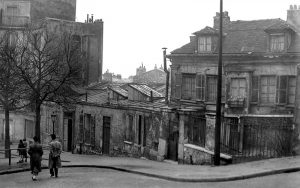 Le Bateaux-Lavoir. (c. 1910). Anonymous Photograph Le Bateaux-Lavoir. (c. 1910). Anonymous Photograph |
We have seen how Impressionism challenged the Mimetic and ideological values of Academic Art with subjective distortions of the image. As the 20th Century dawned, revolutionary artists in Paris began to radically deconstruct the image or eliminate it altogether.
So buckle your seatbelts. For more than 120 years, people have been shrinking from the challenges of “modern art.” Remember—you are never required to like anything in our class. But let’s try to get a grip on the games that these artists are playing.
Henri Matisse and Fauvism
As is so often the case, the term Fauvism was originally used to by disapproving critics to disparage the savages led by Henri Matisse:
Fauvism
Taking his cue especially from Cézanne, Matisse radically challenged the Renaissance idea that a painting functioned as a window on the world. His famous work, La Danse depicts lively women. But they dance outside of time on a shapeless, dislocated green space. While depth is inscribed in the dancers’ circle, the rest of the image has been flattened to eliminate linear perspective. Figures are rendered with a few deft sketch lines and sheer colors dominate.
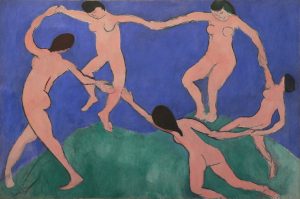 |
 |
| La Danse (first version). (1909).Oil on canvas. | (1948). Two Girls, Red and Green Background. Oil on canvas. |
Matisse’s Two Girls, Red and Green Background reinvents the Renaissance Convention of Veduta: interior spaces with windows opening onto distant landscapes. But Matisse has no interest in Linear Perspective. Merely suggested features of the room flatten into an expanse of pure color chosen, not to reflect the natural objects, but for sheer expressive impact. For Matisse, the game is always color, often strange, unnatural, sometimes bilious color, and free flowing, flattened shapes with minimal or no depth.
Picasso and the Fractured Image
Barcelona native Pablo Picasso first visited Paris in 1900, settling for a decade into le Bateaux-Lavoir and poverty. He struggled to find a style that would express his imagination … and sell! Through 1904, during his famous “Blue Period,” Picasso depicted the poor and the outcast in compositions chilled by the coldest hues.
 |
 |
|
| Woman Ironing. (1904). Oil on canvas. | La Vie. (1904) Oil on canvas. | Old Guitarist. (1904). Oil on panel. |
Picasso’s reputation for bewildering visual puzzles scares off many viewers. However, if one looked only at the Blue Period, one might ask what all the fuss was about. The long, lean figures are austere but elegant, quiet celebrations of the lives of the working poor.
But of course Picasso didn’t stop there. Around 1905, he began a year’s work on a large canvas that he showed no one until it was finished. Like many works of art that change the game forever, Les Demoiselles d’Avignon was not received well initially, even by friends and collaborators. The piece challenges us to think hard about what we are seeing.
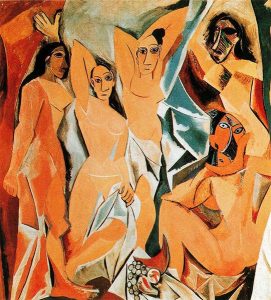
Les Demoiselles d’Avignon. (1907). Oil on canvas. |
Some elements of the painting are traditional. The subject matter is straightforward, if a bit sordid: the women of a brothel in Montmartre. Notice the fruit, typical components of a Still Life. The faces of the two central women are drawn in the traditional style of Spanish folk art. But what of those other two faces?
Our first clue lies in the angular, geometric features of ritual masks from African cultures. African art was at the time becoming popular among artists and sophisticated people in Paris and New York. Picasso was fascinated by the way these conventions broke the image of a face into roughly geometrical shapes. He felt liberated to fracture a composition into disparate pieces, reflecting different styles. The features of the lowest face are dramatically stylized and portrayed from multiple perspectives.
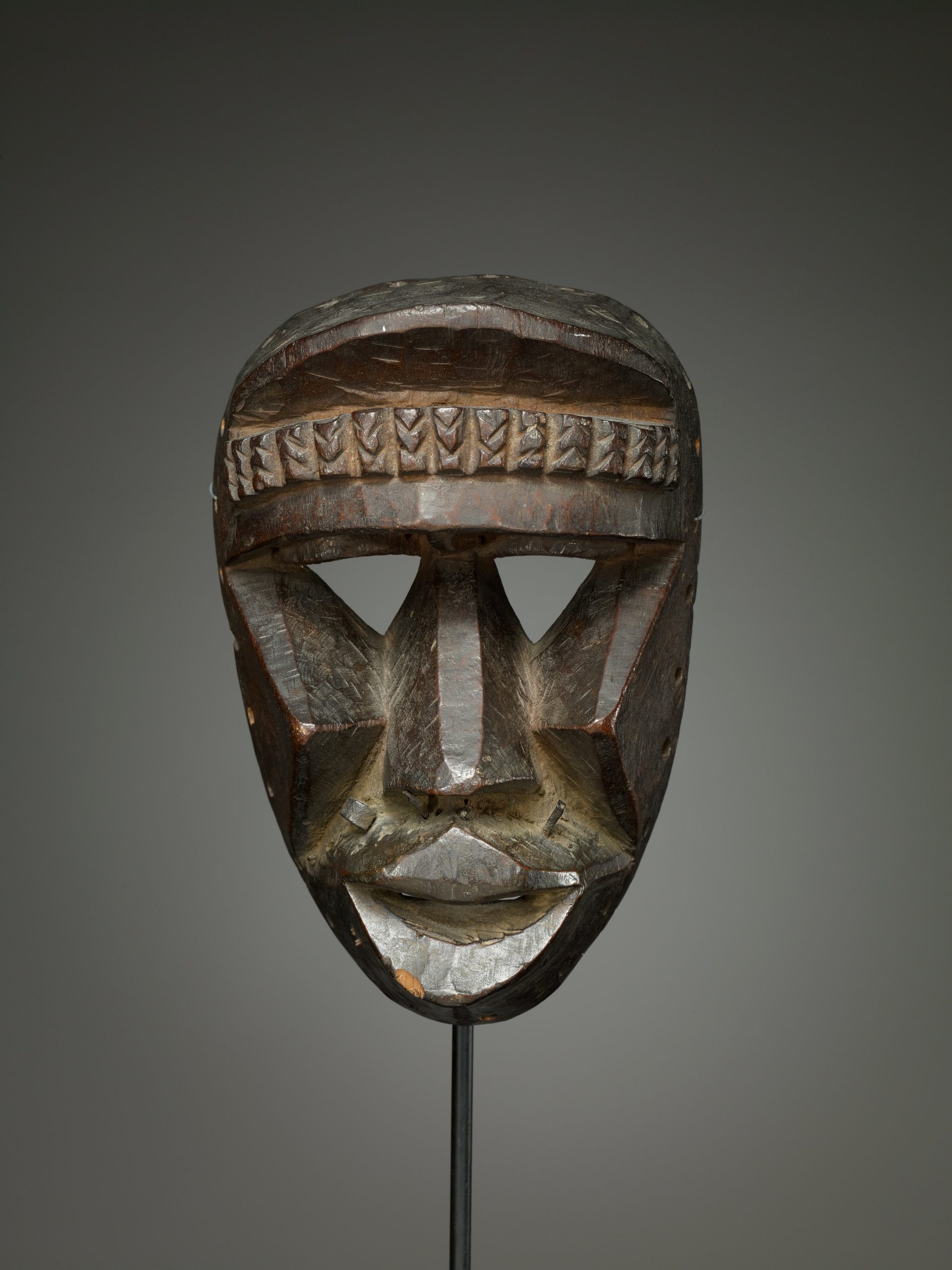 |
 |
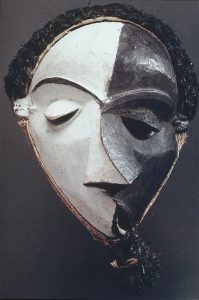 |
| Kagle Mask. Dan People. | Les Demoiselles d’Avignon, detail. | Pende Mbuyu (Sickness) Mask. Painted wood, fiber, cloth. |
The deconstruction of figures pioneered in Les Demoiselles d’Avignon led Picasso and his close friend Georges Braque into an even more radical form: Cubism. The Cubists pushed to an extreme the ancient Egyptian habit of viewing a subject from multiple viewpoints at once. They fractured elements of the object “into a large number of small, intricately hinged planes that fuse with one another and with the surrounding space” (Cubism). Focused on visual structure, they limited their virtually Monochromatic Color Palette to muted browns or greys.
| |
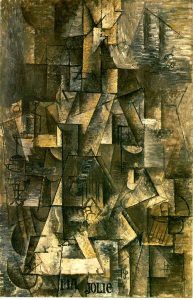 |
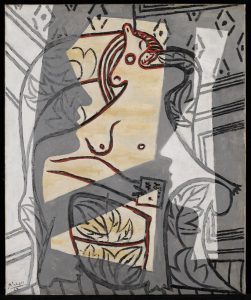 |
| Georges Braque. (1913). Woman with a Guitar. Oil on Canvas. | Picasso. (1907). Ma Jolie (Femme a la guitare). Oil on Canvas. | Picasso. (1907) Woman in an Armchair. Oil on canvas. |
But what is it supposed to be? Cubist compositions like Ma Jolie actually do depict visual subjects, or, at least, fragments of them. They invite the viewer to unpack the puzzle, finding the actual images and playing them against the larger play of color and structure. Can you see the woman or the guitar?
Picasso moved on to experiment more and more daringly with deconstructed images. Woman in an Armchair deconstructs commonplace subjects and reassembles them in a visual game of challenging complexity. Can you play? Remember: the Composition will fuse multiple viewpoints at once. Can you see the facing profiles? The wings of the armchair? Notice how the lines of the trim on the wall create compositional lines that flatten Linear Perspective.
In 1936, Picasso’s native Spain erupted into civil war. The fascist forces of Francisco Franco were heavily supported by Adolf Hitler’s German military. On April 26th, 1937, the Luftwaffe [Air Force of Nazi Germany] bombed the Spanish town of Guernica, killing hundreds, if not thousands, and inspiring perhaps the world’s greatest protest painting: Picasso’s Guernica.
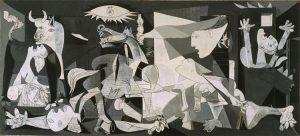 Guernica. (1939). Oil on Canvas. Guernica. (1939). Oil on Canvas. |
Picasso composed Guernica to exorcise his profound distress in reading newspaper articles about the slaughter of his Spanish country men and women. Blacks and grays emulate the tones of newsprint. Picasso uses deconstructive techniques to portray the agony of people, children, and animals dismembered by war. Some of the distorted heads expand like balloons, perhaps suggesting the accusing ghosts of the victims. That bull in the upper left has been the subject of many interpretations. It is probably safe to suggest deep links with the Spanish people who love their bulls and who have endured repeated invasions and civil wars for thousands of years. All seems to be contained in a single room with a lone light bulb telling the tale of the atrocity.
For many years, Guernica was referred to as the greatest painting of the century. Whether or not we “like” it or would enjoy hanging it in our living rooms, it surely has an impact for the patient, the observant, and the thoughtful.
“The Man with the Blue Guitar”
Wallace Stevens, from “The Man with the Blue Guitar” (1937)
Wallace Stevens, from “The Man with the Blue Guitar” (1937)
I
The man bent over his guitar,
A shearsman of sorts. The day was green.
They said, ‘You have a blue guitar,
You do not play things as they are.’
The man replied, ‘Things as they are
Are changed upon the blue guitar.’
And they said then, ‘But play, you must,
A tune beyond us, yet ourselves,
A tune upon the blue guitar
Of things exactly as they are.
“A tune beyond us, yet ourselves.” Wallace Stevens wrote deeply reflective poems probing boundaries between subjectivity and “reality.” “Notes toward a Supreme Fiction” (1942), explores interfaces between imagination, faith, myth, and art. Stevens was fascinated by the way contemporary artists such as Picasso playfully and provocatively manipulated that boundary. Our excerpt from a long poem poses the challenge faced by audiences who on the one hand want art to take them beyond their reality and on the other become frightened and impatient when they lose touch with what they know.
Surrealism
In 1900, Sigmund Freud published The Interpretation of Dreams. This watershed work challenged people throughout the world to consider levels of the mind other than consciousness. Freud’s notion of the traumwerke—dreamwork—opened psychology and the arts to deep structures of meaning that found expression in the Surrealist movement:
Surrealism
Salvador Dali’s The Persistence of Memory rather plainly lays out a land and seascape with conventional perspective. The objects are all recognizable. They are also impossible, warped by the twisting effects of dreams.
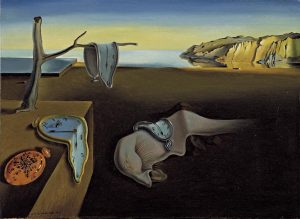 |
 |
| The Persistence of Memory. (1931). Oil on canvas. | Carl Van Vechten. (1939). Portrait of Salvador Dali. |
So what’s with those drooping clocks? Let your mind play. Clocks, time, dreamwork … subjective time. Remember the title: memory with all of its annoying, distorting persistence. Art is no more of a distortion of “reality” than is our all too human remembered fantasy.
By the way, Dali played a role in a major film directed by Alfred Hitchcock. In Spellbound (1941), Gregory Peck’s character undergoes intensive psychoanalysis. Under hypnosis, he experiences a vivid dream vision. We experience that vision in a dream sequence fusing cinematography, animation, and set design, all composed by Salvador Dali.
Bonus video: Dalí, Salvador. (1945). Dream Sequence. In Alfred Hitchcock’s Spellbound.
Abstract Art
All of which brings us to the supreme moment of art subverting classical conventions. We’ve seen artists distort and deconstruct the visual subject. In 20th Century Abstract art, artists began to ignore altogether the task of depicting a visual subject.
Abstract Art
The conceptual seeds of abstract art go back as far as Plato, 2,500 years ago. In the Philebus dialogue, Socrates says “I do not mean by beauty of form such beauty as that of animals and pictures…but straight lines and circles, and the plane or solid figures which are formed out of them … for these I affirm to be … eternally and absolutely beautiful.” The 19th Century English painter Joshua Reynolds wrote, “the beauty of form alone… makes of itself a great work, and justly claims our esteem and admiration” (Abstract art).
But what is it supposed to be? Many, many viewers balk at art that represents nothing. If you are skeptical, let me remind you that you enjoy abstract designs in your home every day: Tartan plaids, polka dots, pin stripes, geometrical designs and more in clothing, wallpaper, and furniture coverings. Still, you are free to finally turn away.
Still, give it a try. Bring to bear some of what you have learned about Formal Art Elements: Line, Shape, Form, Color, Composition, Unity, Harmony, Rhythm, Balance. Open yourself to the rich, resonant textures of abstract art. Maybe you’ll enjoy it!
Wassily Kandinski, Pioneer of Abstraction
Wassily Kandinsky’s … coloring became very intense under the influence of Fauvism, and his forms became flatter and more attenuated until they began to lose their representational identity. … [He] described how he came to recognize that color and line in themselves could be sufficient vehicles for the expression of emotions. … He did not completely repudiate representation … but he held that the “pure” artist seeks to express only “inner and essential” feelings. … He argued that if the artist could go beyond the outer shell of appearances he could “touch the beholder’s soul.” Color was a prime means of achieving this goal, for he believed that colors have “a spiritual vibration” that could be linked with “a corresponding vibration in the human soul.” (Kandinsky, Wassily).
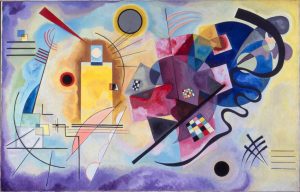 Wassily Kandinsky. (1925). Yellow, Red, Blue. Oil on canvas. Wassily Kandinsky. (1925). Yellow, Red, Blue. Oil on canvas. |
The title of Kaninsky’s Yellow, Red, and Blue suggests a purely formal, abstract composition. And indeed the powerful colors exert their spell along with deftly alternated geometrical and organic shapes and lines. However, I’ll bet you will tend to “see” represented subjects in the design. Even in the most random visual features, our eyes are powerfully inclined to see objects that we recognize. Kandinsky has dramatically shifted the focus away from Representation, but rudimentary visual subjects persist.
Bands of Drenching Color: Mark Rothko
The canvases for which Mark Rothko is famous follow a predictable abstract formula: horizontal bands of color. Yet many people find his work more accessible than other abstracts.
But are they abstracts? Rothko described his paintings as “dramas; the shapes in the pictures are the performers.”
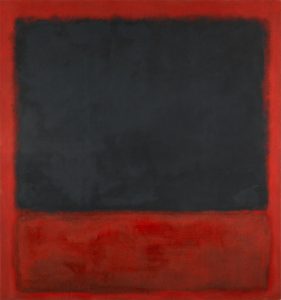 |
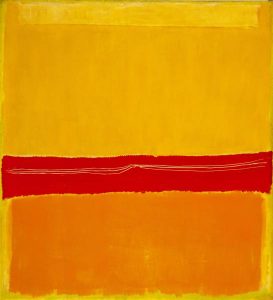 |
| Untitled (Black, Red over Black on Red). (1964).Oil on canvas. | No.5/No.22. (1964). Oil on canvas. |
So what is that brings people to tears in front of pure color and form? In part, surely we respond to the dense, drenching colors, often deep, organic reds. But there is something mesmerizing about those borders, never geometrical, always organic, invariably layered and bleeding. The WikiArt gloss for No. 5/No. 22 explores this visual ambivalence:
Blessed Rage for Order:
Piet Mondrian
Before World War I, the Dutch painter Piet Mondrian painted landscapes and seascapes. Then, horrified by the war, he began to cultivate a purely formal, abstract style:
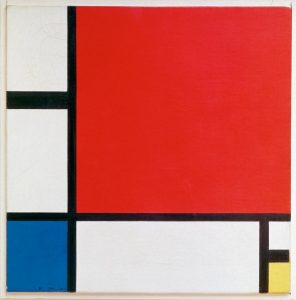 Piet Mondrian. (1930): Composition with Red, Blue, and Yellow. Piet Mondrian. (1930): Composition with Red, Blue, and Yellow. |
So what do we have here? Line. Colored rectangles in primary colors. Given a ruler and an elementary paint set, a child could do this, right?
Well, no. The design turns out to be astonishingly complex, an exercise in Composition. Look closely at the lines. They vary in width. Some continue to the edge of the canvas. The vertical line on the left does not, allowing the top left rectangle to open out into unbounded space. Dynamic tension between open and closed spaces always enlivens a Mondrian. Notice as well the Asymmetrical Balance that matches the large red square diagonally to the smaller blue and vertically with the yellow. Exploring a Mondrian is an exercise in analyzing composition.
Abstract Expressionism: Jackson Pollock
Perhaps the high-water mark of Modernist, Abstract Art emerged in the 1940s: Abstract Expressionism, the first American art movement to achieve international acclaim. Fired by “a spirit of revolt against tradition and a belief in spontaneous freedom of expression,” Abstract Expressionists like Jackson Pollock produced large canvases that glorified the “absolute individuality of the artist” and the “act of painting itself.” Like Rothko, these radical artists painted under the “conviction that abstract painting could convey significant meaning” with audacious paint alone (Abstract Expressionism).
One of the avatars of abstract expressionism was Jackson Pollock:
Jackson Pollock …
 |
 |
| Number 1 (Lavender Mist). (1950). Oil, enamel, aluminum canvas | Number 18. (1950). Oil and enamel on Masonite |
Many people are completely put off by the apparent chaos of a Pollock. Anyone can drip paint on a canvas! Yet standing in front of one of Pollock’s numbered painting is a remarkable experience. One is staggered by the density of visual elements. Globs of paint, bits of string and other materials create in his vast canvases a density of texture impossible to convey in a photograph. Not so random lines, arcs, and daubs of paint constellate, rhythmically repeat, and duel for dominance. If one gives oneself up to the sheer experience of paint, canvas, line, light, dark, color, and especially texture, one can become rapt in a dramatic visual dialogue. We detect no represented subject, but, perhaps because of this, our eyes are absorbed in a stunningly rich encounter.
If you wonder how one could possibly “read” such a painting, explore the O’Connor article on him. O’Connor provides a fascinating analysis of Pollock’s No. 2 that unlocks the intension and design lying within the apparently chaotic visual elements. You may or may not be persuaded, but hopefully you will begin to see that work like this has great depth and richness.
References
Abstract art [Article]. (2015). In I. Chilvers & J. Glaves-Smith (Ed.s), The Oxford Dictionary of Art. Oxford University Press. http://www.oxfordreference.com.ezproxy.bethel.edu/view/10.1093/acref/9780198604761.001.0001/acref-9780198604761-e-13.
Abstract expressionism [Article]. (2015). In I. Chilvers & J. Glaves-Smith (Ed.s), A Dictionary of Modern and Contemporary Art. Oxford University Press. https://www.oxfordreference.com/view/10.1093/acref/9780191792229.001.0001/acref-9780191792229-e-14.
Braque, G. (Autumn 1913). Woman with a Guitar (Femme à la guitare; La joueuse de guitare; La guitariste; Jeune fille à la mandoline). [Painting]. Paris, France: Musée National d’Art Moderne. ARTstor https://library-artstor-org.ezproxy.bethel.edu/asset/AWSS35953_35953_30936255.
Cubism. (2004). [Article]. In I. Chilvers (Ed.), The Oxford Dictionary of Art. Oxford University Press. http://www.oxfordreference.com.ezproxy.bethel.edu/view/10.1093/acref/9780198604761.001.0001/acref-9780198604761-e-949.
Dalí, S. (1931). The Persistence of Memory. [Painting]. New York, NY: Museum of Modern Art. ID 79018. ARTstor https://library-artstor-org.ezproxy.bethel.edu/asset/AMOMA_10312310520.
Dalí, S. (1945). Dream Sequence. Hitchcock, A. [Dir.]. Spellbound [Film] Selznick International Pictures. https://www.youtube.com/watch?v=JyPe1Jahyfo.
Fauvism. (2004). [Article]. In I. Chilvers (Ed.), The Oxford Dictionary of Art. Oxford University Press. http://www.oxfordreference.com.ezproxy.bethel.edu/view/10.1093/acref/9780198604761.001.0001/acref-9780198604761-e-1238.
“Kagle” Mask. Dan People. (n.d.). Minneapolis, MN: Minneapolis Institute of Arts. Accession number 2011. 70.2. https://collections.artsmia.org/art/113448/kagle-mask-dan.
Kandinsky, W. (1925). Yellow, Red, Blue [Painting]. ARTstor https://library-artstor-org.ezproxy.bethel.edu/asset/ARTSTOR_103_41822000983229.
Kandinsky, W. [Article]. (2015). In I. Chilvers & J. Glaves-Smith (Ed.s), A Dictionary of Modern and Contemporary Art. Oxford University Press. https://www.oxfordreference.com/view/10.1093/acref/9780191792229.001.0001/acref-9780191792229-e-1348.
Le Bateau-Lavoir [Photograph] (c. 1910). Wikipedia https://en.wikipedia.org/wiki/Bateau-Lavoir#/media/File:Le_Bateau-Lavoir,_circa_1910.jpg.
Magritte, R. (1933). The Human Condition [Painting]. Washington D.C.: National Gallery of Art. ARTstor https://library-artstor-org.ezproxy.bethel.edu/asset/AMICO_CL_103803515.
Mondrian, P. (1930). Composition with Red, Blue, and Yellow. [Painting]. Zürich, Germany: Zürich Museum of Art. ARTstor https://library-artstor-org.ezproxy.bethel.edu/asset/LESSING_ART_10310751326.
Mondrian, P. [Article]. (2015). In I. Chilvers & J. Glaves-Smith (Ed.s), A Dictionary of Modern and Contemporary Art. Oxford University Press. https://www.oxfordreference.com/view/10.1093/acref/9780191792229.001.0001/acref-9780191792229-e-1804.
No.5/No.22. (2012). [Article]. WickiArt: Visual Art Encyclopedia. https://www.wikiart.org/en/mark-rothko/no-5-no-22.
O’Connor, F. (2011). Pollock, Jackson. In J. Marter (Ed.), The Grove Encyclopedia of American Art. Oxford University Press. https://www.oxfordreference.com/view/10.1093/acref/9780195335798.001.0001/acref-9780195335798-e-1623.
Pende people, Zaire. (N. D.). Mbuya (Sickness) Mask. https://library-artstor-org.ezproxy.bethel.edu/#/asset/ARTSTOR_103_41822001426186.
Picasso, P. (1907). Les Demoiselles d’Avignon [Painting] New York: Museum of Modern Art. Wikiart https://www.wikiart.org/en/pablo-picasso/the-girls-of-avignon-1907.
Picasso, P. (1937). Guernica [Painting]. Madrid, Spain: Museo Nacional Centro de Arte Reina Sofía. Wikiart https://www.wikiart.org/en/pablo-picasso/guernica-1937.
Picasso, P. (1904). La Vie [Painting]. Cleveland, OH: Cleveland Museum of Art. Wikiart https://www.wikiart.org/en/pablo-picasso/life-1903.
Picasso, P. (1904). The Old Guitar Guitarist [Painting]. Chicago IL: Art Institute of Chicago. Reference number 1926.253. Wikipedia https://en.wikipedia.org/wiki/Picasso%27s_Blue_Period.
Picasso, P. (1907). Ma Jolie (Femme a la guitare) [Painting]. Wikiart https://www.wikiart.org/en/pablo-picasso/my-beautiful-woman-with-guitar-1912.
Picasso, P. (1904). Woman Ironing [Painting]. New York, NY: Thannhauser Collection, Solomon R. Guggenheim Museum, Accession 78.2514.41. https://www.guggenheim.org/artwork/3417.
Picasso, P. (1927). Woman in an armchair [Painting]. Minneapolis, MN: Minneapolis Institute of Art. https://collections.artsmia.org/art/1517/woman-in-an-armchair-pablo-picasso.
Picasso, Pablo. (1907). Ma Jolie (Femme a la guitare) [Painting]. https://www.wikiart.org/en/pablo-picasso/my-beautiful-woman-with-guitar-1912.
Picasso, Pablo [Article]. (2004). In I. Chilvers (Ed.), The Oxford Dictionary of Art. Oxford University Press. http://www.oxfordreference.com.ezproxy.bethel.edu/view/10.1093/acref/9780198604761.001.0001/acref-9780198604761-e-2739.
Pollock, J. (1950). Number 1 (Lavender Mist) [Painting]. Washington D.C.: National Gallery of Art. 1976.37.1. https://www.wikiart.org/en/jackson-pollock/number-1-lavender-mist-1950-1.
Raguenet, J-B. (1763). A View of Paris from the Pont Neuf [Painting]. Los Angeles, CA: Getty Museum, ID 71.PA.26. http://www.getty.edu/art/collection/objects/581/jean-baptiste-raguenet-a-view-of-paris-from-the-pont-neuf-french-1763/.
Rothko, M. (1964). No.5/No.22 [Painting] New York, NY: Museum of Modern Art. https://www.wikiart.org/en/mark-rothko/no-5-no-22.
Rothko, M. (1964). Untitled (Black, Red over Black on Red) [Painting]. Paris, France: Musée National d’Art Moderne, Centre Georges Pompidou. Accession Number AM 2007-126. https://library-artstor-org.ezproxy.bethel.edu/asset/AWSS35953_35953_30943855.
Rothko, M. [Article]. (2015). In I. Chilvers & J. Glaves-Smith (Ed.s), A Dictionary of Modern and Contemporary Art. Oxford University Press. https://www-oxfordreference-com.ezproxy.bethel.edu/view/10.1093/acref/9780191792229.001.0001/acref-9780191792229-e-2338?rskey=ptKSEO&result=6.
Stevens, W. (1937). “The Man with the Blue Guitar.” Poetry, Vol. 50, No. 2 (May, 1937), pp. 61-69. https://www.writing.upenn.edu/~afilreis/88v/blueguitar.html.
Surrealism. (2004). [Article]. In I. Chilvers (Ed.), The Oxford Dictionary of Art. Oxford University Press. http://www.oxfordreference.com.ezproxy.bethel.edu/view/10.1093/acref/9780198604761.001.0001/acref-9780198604761-e-3405.
Van Vechten, C. (1939). Portrait of Salvador Dali [Photograph]. Washington, D.C.: Library of Congress, LOT 12735. https://commons.wikimedia.org/wiki/File:Salvador_Dal%C3%AD_1939.jpg.
a late 19th Century dissident movement among French artists that challenged the conventions of academic art. Impressionists painted quickly, outside in the plein air, seeking to capture with a few deft strokes the colors, lighting and atmosphere of the scene—their subjective impression rather than the “real thing.”
in visual art, the quality of imitating as closely as possible the appearance of nature, “the real thing." Often contrasted with stylized technique
art that follows explicit rules established by a tradition, institution, academy, or school. Sometimes dismissed by the avant-garde art world as overly cautious, derivative, or unoriginal
an originally negative term for an early 20th Century movement, associated with Henri Matisse, which rejected linear perspective, mimetic precision, and “realistic” colors to cultivate free ranging expression
an era in 15th and 16th century Europe marked by a Renaissance—or rebirth—of interest in and knowledge of classical Greek learning through humanist scholarship that challenged medieval values. In painting and sculpture, the work of artists in Italy, Germany, and the Low Countries which broke with Byzantine conventions to explore the geometry of perception and locate images and actions in time and space
a characteristic feature—subject matter, theme, technique, style—that defines a genre or artistic tradition and is expected and understood by the audience in its context
(Italian: view) a visual composition located in a recognizable landscape. During the Renaissance, often an interior scene with a background window looking out on an identifiable landscape.
the illusion of depth in a 2-dimensional image (e.g. a painting) in which lines angle toward a vanishing point
a genre of painting, drawing, or photograph arranging inanimate objects such as fruit, flowers, pottery or furniture, usually in an interior scene.
a technique which analyzes the visual subject, deconstructing it into fragmented, often geometrical forms that are reassembled into a densely interwoven composition. A muted, narrow color palette focuses the eye on forms and composition that obscure the subject, depicted from several viewpoints at once
a color palette with a noticeably narrow range of Hue and Value
the range of colors selected to compose a painting’s design
in visual art, the arrangement of visual elements for expressive and aesthetic impact: unity, proximity, similarity, variety and harmony, emphasis, rhythm, balance, etc.
a 20th Century movement among painters, photographers, and cinematographers that sought to depict the distorted images, symbols, and phantasms of the unconscious as understood by Sigmund Freud’s ideas of the traumwerke (dream work)
visual art that makes little or no effort to represent any recognizable subject. Abstract art creates a wholly formal design that appeals to purely aesthetic sensibilities.
the elements that form the basis of the language of art irrespective of any subject that may or may not be represented: line, color, form and shape, value, texture, space, and movement.
in visual art, a 1-dimensional path through space including length but not width or depth. Line may be straight or curved, directly drawn or implied, e.g. lines of sight, suggested lines of movement, etc.
in visual art, a 2-dimensional figure with a more or less defined border displaying only height and width
in visual art, a 3-dimensional shape or object with height, width, and depth
a visual subject’s quality or wavelength of light. Components of color include Hue, Value, Saturation (intensity) and Color Temperature
in an artistic composition, parts working together through stylistic and thematic harmony to form an integrated whole
in visual art, a correspondence between unlike elements that contributes to overall unity
an artistic effect generally achieved by repetition of forms. In figurative language, patterns of Scheme which repeat sounds or ideas. In poetry, patterns that arise from repeated elements such as rhyme and meter. In visual art, a sense of movement arising from repeated elements in the composition
in visual art, the distribution of visual weight or placement of elements. Symmetrical balance pairs space and elements of similar weight and scale; Asymmetrical balance opposes unequal elements of weight and scale: e.g. a large open space offset by a small but weighty form.
a function of visual art which seeks to depict a visual subject that viewers will recognize from a theoretical “real world.” Opposite: abstract or non-figurative art
in visual art, an equilibrium achieved between unequal elements of weight and scale in a visual field or along off center vertical or horizontal axes: e.g. a large open space offset by a small but weighty form
a mid-20th Century movement of painters in America who sought to express powerful themes and emotions on large scale canvases with the textures of the medium: paint, brushstrokes, and added materials such as string or paper. Apparently chaotic compositions display order and patterns on closer inspection.

